The AMD Radeon R9 290 Review
by Ryan Smith on November 5, 2013 12:01 AM EST- Posted in
- GPUs
- AMD
- Radeon
- Hawaii
- Radeon 200
Overclocking
Finally, let’s spend a bit of time looking at the overclocking prospects for the 290. Without any voltage adjustment capabilities and with AMD binning chips for clockspeeds and power consumption we’re not necessarily expecting a lot of headroom here, but none the less it’s worth checking out to see how much more we can squeeze out of the card.
Even though we’re officially limited to AMD’s Overdrive utility for the moment for overclocking, Overdrive offers a wide enough range of values that we shouldn’t have any problem maxing out the card. In fact we’ll be limited by the card first.
| Radeon R9 290 Overclocking | |||
| Reference Radeon R9 290 | |||
| Shipping Core Clock | 662MHz | ||
| Shipping Boost Clock | 947MHz | ||
| Shipping Memory Clock | 5GHz | ||
| Shipping Boost Voltage | ~1.18v | ||
| Overclock Core Clock | 790MHz | ||
| Overclock Boost Clock | 1075MHz | ||
| Overclock Memory Clock | 5.6GHz | ||
| Overclock Max Boost Voltage | ~1.18v | ||
Despite the lack of voltage control, when it comes to overclocking the 290 we were able to achieve solid overclocks on both the GPU and the memory. On a boost clock basis we were able to push the 290 from 947MHz to 1075MHz, an increase of 128MHz (14%). Meanwhile we were able to push the memory from 5GHz to 5.6GHz before artifacting set in, representing a 600MHz (12%) memory overclock. Being able to increase both clockspeeds to such a similar degree means that no matter what the video bottleneck is – be it GPU or memory – we should see some kind of performance increase out of overclocking.
On a side note, for overclocking the 290 we stuck with moderate increases to both the maximum fan speed and the PowerTune limit. In the case of the former we used a 65% maximum fan speed (which actually proved to be more than what’s necessary), while for the latter we went with a 20% increase in the PowerTune limit, as at this point in time we don’t have a good idea for what the safe power limits are for the reference 290/290X board. Though in either case only FurMark could push the overclocked card to its power limit, and nothing could push the card to its fan speed limit. Similarly we didn’t encounter any throttling issues with our overclocked settings, with every game (including CoH2) running at 1075MHz sustained.
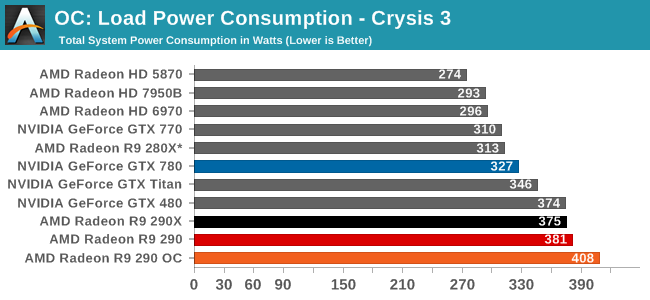
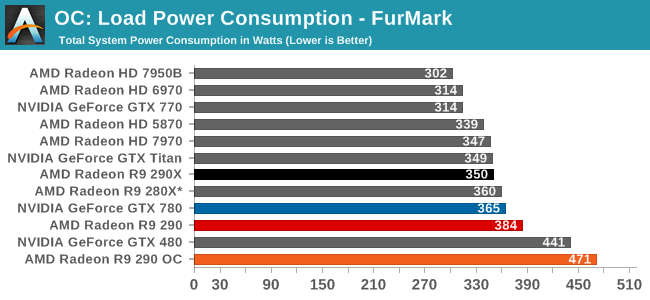
Taking a brief look at power, temp, and noise before jumping into our gaming performance results, we can see that overclocking the card has a measurable impact on power consumption under both Crysis 3 and FurMark. With Crysis 3 we’re clockspeed limited before we’re power limited, leading to an increase in power consumption of 27W, while under FurMark where we were power limited it’s a much more academic increase of 87W.
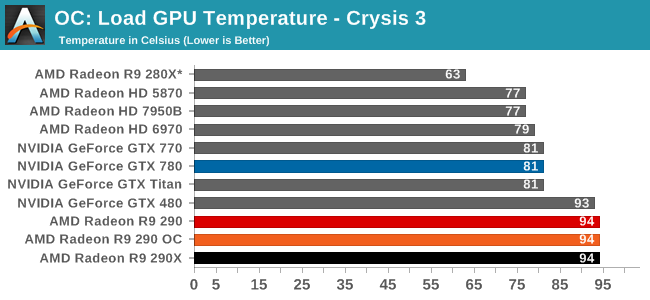
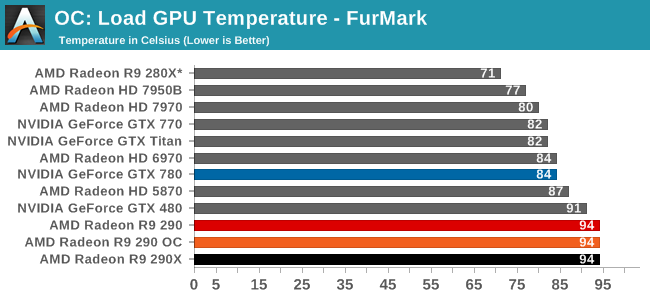
Since the 290 already ships at the highest temperate limit it allows – 95C – our sustained temperatures are unchanged even after overclocking.
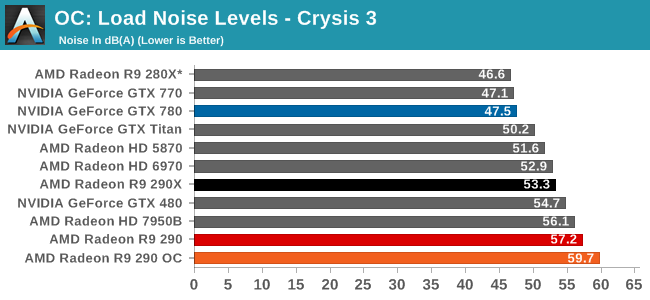
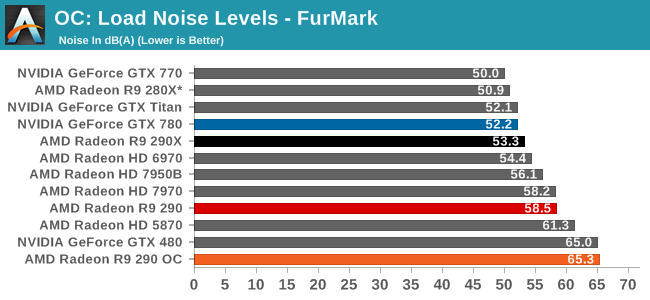
The 290 is already an unreasonably loud card at stock, and unfortunately the fan speed increases needed to handle the greater heat load from overclocking only make this worse. Under Crysis 3 we peaked at 59.7dB, or 49% fan speed. While under FurMark we peaked at 65.3dB, or 59% fan speed. For these noise levels to be bearable the 290 really needs to be fully isolated (e.g. in another room) or put under water, as otherwise 59.7dB sustained is immensely loud for a video card.
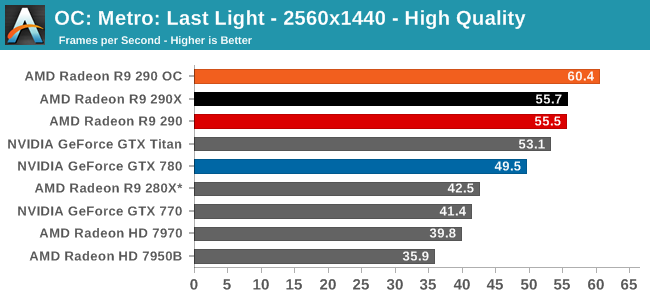
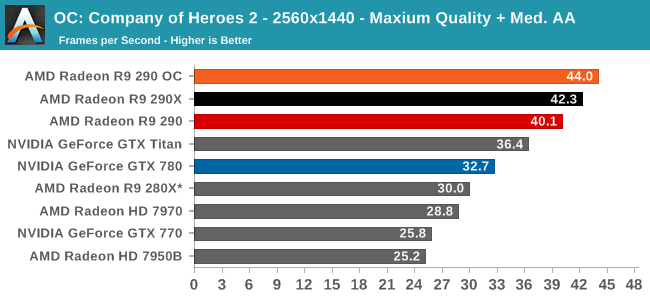
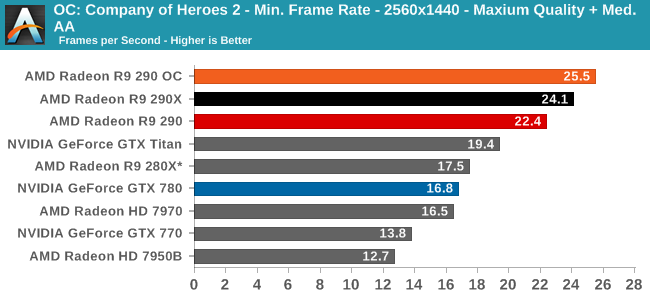
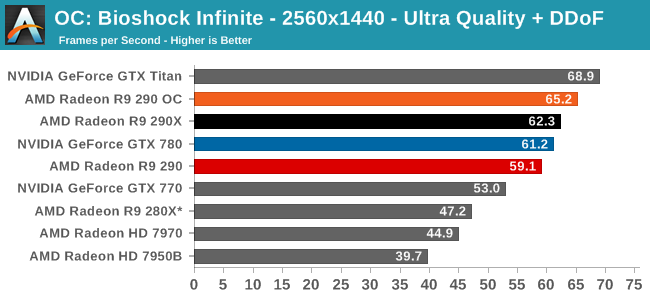
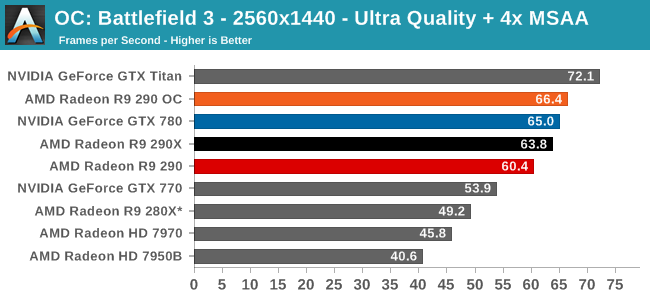
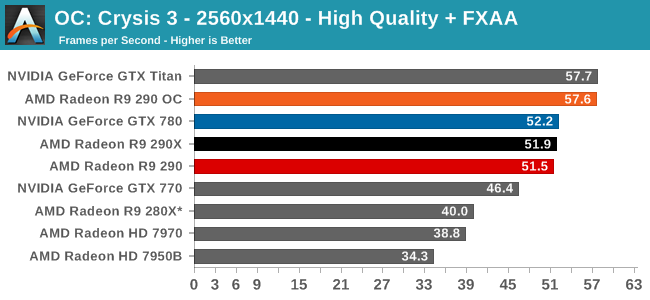
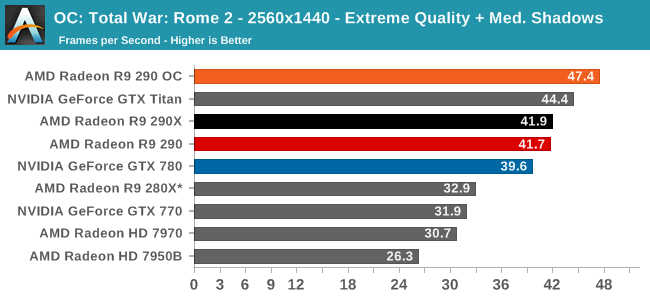
Finally getting to the matter of game performance, we’re seeing consistently strong scaling across every game in our collection. The specific performance increase depends on the game as always, but a 14% core overclock and 12% memory overclock has netted us anywhere between 9% in Metro up to the full 14% in Total War: Rome II. At this performance level the 290 OC exceeds the performance of any other single-GPU card at stock, and comes very close to delivering 60fps in every action game in our benchmark suite.










295 Comments
View All Comments
Sunburn74 - Tuesday, November 5, 2013 - link
Too hot and too loud for any activity other than gaming on a headset. Maybe aftermarket coolers will salvage this card.megalee - Tuesday, November 5, 2013 - link
Well, I have the headphones on while gaming so I don't care about the noise. Sounds like a good deal to me. Good to see some competition!asphix - Tuesday, November 5, 2013 - link
1st -- to anyone claiming that after market coolers will solve the heat/noise issue... you are correct.. but it will come at a cost. Say hello to a $450-$500 R9 290. Only time will tell, but my guess is they will either be mediocre solutions to keep the price down, or expensive (as will need to be to deal with that kind of dissipation).2nd -- AMD has one goal and only one goal with these extreme price points and that's to get themselves out of this catch 22 situation with mantle. In order for developers to program for mantle, there needs to be a user base. The user base will grow if there is mantle. Release cards that are relatively cheap with steep trade-offs to grow userbase. I feel the next release cycle will have more expensive cards with less trade-offs (noise/heat) and even better performance. It all depends on if mantle takes off which depends on people purchasing these cards.
I love the competition! I really dislike these sacrifices AMD are making to compete with Nvidia. However, i understand why the're doing it the way they are and I hope they're successful with it.
haukionkannel - Tuesday, November 5, 2013 - link
If you compare the price of reference 7970 and aftermarket cooler version of 7970, the difference is 10-50$ Nothing too bad... This just shows how bad this AMD reference is... ingredible!http://www.tomshardware.com/reviews/radeon-r9-290-...
But we vary, there may be something fishy with AMD press cards! It may be that retail makers are making even worse job with reference cooler, but now it is time to wait some good aftermarket cooler cards!
MarkcusD - Tuesday, November 5, 2013 - link
"290 is essentially twice as loud as the GTX 780"Lol. What a POS. Seriously it may improve with some non-stock coolers, but I wouldn't touch this card.
willis936 - Tuesday, November 5, 2013 - link
If you convert to linear sound levels it's actually three times as loud. That's mostly academic though.supamark - Tuesday, November 5, 2013 - link
Actually, it's just short of 10 times as loud - it's a log scale.jonjonjonj - Tuesday, November 5, 2013 - link
i get that anand cant recommend the card because of the noise. but i think amd is going to sell a lot of these cards because in the end its all about performance and price. plus who buys a reference card anyway? on the asus cards i have owned you can turn the fan to 100% and its silent. some 3rd party card will come out with a quiet cooler that also unleashes the 290.superjim - Tuesday, November 5, 2013 - link
Wait for OEMs to get out their custom cards with the quiet/cooler open air fans and the 290 will be near perfect at $400.jb14 - Tuesday, November 5, 2013 - link
This card is like a drag race car. Pedal flat to the floor, screamingly loud, burning through petrol, pretty cheap (50W increase - crazy)! The only good thing here is the price/performance shaking things up alittle. NV could also quite happily dump an extra 50W through their cards and we could have to two screaming cards next to each other!I have an AMD card in my laptop but wouldn't consider touching this card in the desktop unless it had some seriously beefed up non-custom coolers. Let's see what the AMD partners can do to try and tame this beast!